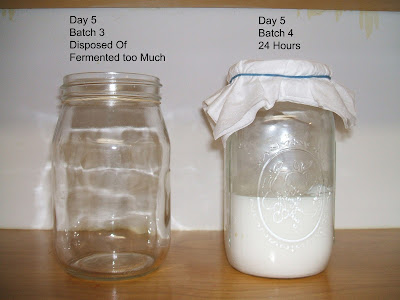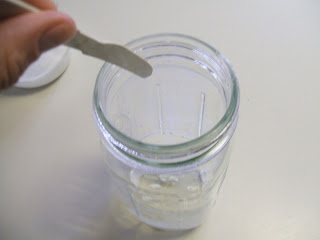Day 4 seems to have produced some promising results. Batch number 2 at the 48 hour mark had the most amazing smell to it. It was like a very sweet yogurt. It reminded me of the Trix Yogurt or the Gogurt I used to eat growing up. The smell was amazing.
Some interesting things have begun to occur with this batch as well. For starters, BOTH jars had fermented to a point of becoming clumpy and very difficult to strain.
Here is a photo of Batch 2 after 48 hours of fermentation (24 hours with kefir grains & 24 hours without the grains). Notice the thick layer on top. The smell of this was fantastic. It almost made me want to consume it. But allas, I won't be doing that for a while yet.
Here is a closer view of Batch 2. The entire thing was creamy throughout. The top layer is more of a cream color compared the to rest which still maintained it's milk appearance in color.
It looked and smelled exactly like yogurt. This is a sign that the kefir grains are gaining in both strength and numbers. This also tells me that I will need to increase the amount of milk I have been providing for them to feed off.

 Became rather surprised when I attempted to strain the milk from the jar with the kefir in it
Became rather surprised when I attempted to strain the milk from the jar with the kefir in it. As you can see from the photo, this wasn't easy. The entire jar had the consistency of very small curd cottage cheese, only a little runnier. This presented a dilemma for me. I needed to strain as much of it as I could so that I only had the clumpy mixture left over to add back.
. First I poured the milk into the jar with the kefir and mixed it well. Then I poured small amounts of the fluid into the strainer and moved it around to drain off as much liquid as possible. Then I rinsed and dried the strainer after each pour.
Once I had strained as much liquid from the grains as I could, I cleaned out the jar they had been in previously and added the contents back. What your seeing in this photo isn't an overgrowth of milk kefir grains from day 3 to day 4 alone. It is also curd, which has fermented and attached itself to the existing kefir grains.
The grains themselves are still fairly small at this time and I don't want to interrupt the process too much. I drained off all the liquid I could and put the entire contents back into the jar instead of trying to break it apart and separate it into curd and kefir grains.
Either way, they are working very hard to have completely thickened the milk in only 24 hours time. Some changes now need to be made.

Here is what the contents now look like after they have been added back to the jar. Looks just like cottage cheese to me.
After returning the kefir grains to a clean jar, I measured out 8 oz of milk. This is double what I have been using.
I then measured out an additional 4 oz for a total of 12 oz added back to the kefir. This will hopefully give me a slight buffer and prevent such overgrowth of curd from happening in the first jar. I would love to see that happening in the second jar but not the jar with the milk kefir grains present.
As I had to add more milk to the contents of batch 3 to make it liquid enough to even pour, I disposed of the contents afterward.
I could have allowed them to ferment in the second jar with the addition of 4 oz fresh cold milk but decided at this point I would focus on the newest batch instead.
We can see now that the process is beginning to speed up. I want to see now how the grains will perform with 12 oz of milk instead of only 4 oz.
My hope is that the first jar will remain fluid enough to pour nicely into the second jar for more fermentation after 24 hours. I would like to separate some of the curd from the kefir grains fairly soon. Hopefully the extra milk will help this to happen. I have been agitating the grains and milk 2X during fermentation. Once at the 8 hour mark and again once upon waking in the morning.
 This means that this batch fermented slightly slower than the previous one. I also kept the temperature of the room between 60-63 degrees F. Although liquid whey did form on the bottom in large quantities, there was a less uniform separation throughout.
This means that this batch fermented slightly slower than the previous one. I also kept the temperature of the room between 60-63 degrees F. Although liquid whey did form on the bottom in large quantities, there was a less uniform separation throughout.  After straining off the newest batch of milk, I was still unsatisfied with the smell. HOWEVER, as the batches were fermenting prior to curd / whey separation, the aroma did have the illusion of yogurt again. It wasn't until I removed the covering at the second 24-hour mark, that I noticed it still wasn't the aroma I am waiting for.
After straining off the newest batch of milk, I was still unsatisfied with the smell. HOWEVER, as the batches were fermenting prior to curd / whey separation, the aroma did have the illusion of yogurt again. It wasn't until I removed the covering at the second 24-hour mark, that I noticed it still wasn't the aroma I am waiting for.  The curd / kefir grains that remained in the strainer after removing the milk, were breifly rinsed with fresh milk. I did this by leaving them in the strainer and poured a cup of fresh milk over them. Then I returned them to a clean jar and added only 8 oz of milk. I wont be trying to wait exactly 24 hours any more, as I will be consuming the kefir from here on out according to taste and texture. I will try various stages of fermentation and keep you posted. My immediate goals are to make the grains odorless to semi-sweet. I will be using less milk to better control the process without wasting anything in the mean time.
The curd / kefir grains that remained in the strainer after removing the milk, were breifly rinsed with fresh milk. I did this by leaving them in the strainer and poured a cup of fresh milk over them. Then I returned them to a clean jar and added only 8 oz of milk. I wont be trying to wait exactly 24 hours any more, as I will be consuming the kefir from here on out according to taste and texture. I will try various stages of fermentation and keep you posted. My immediate goals are to make the grains odorless to semi-sweet. I will be using less milk to better control the process without wasting anything in the mean time.



















































